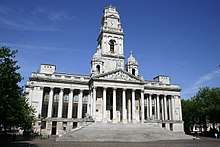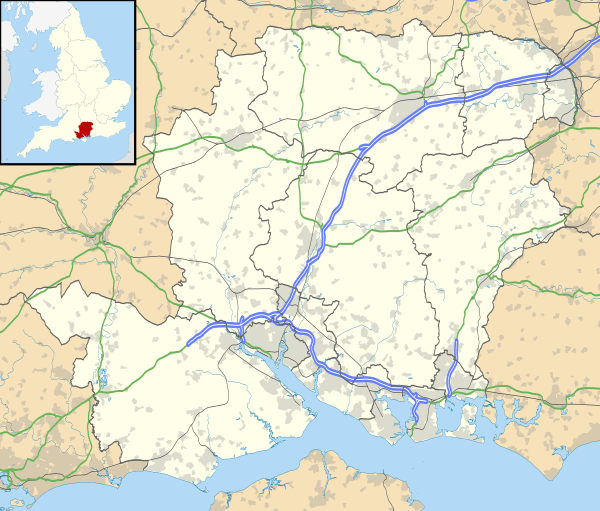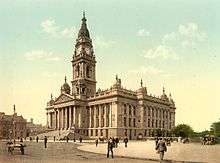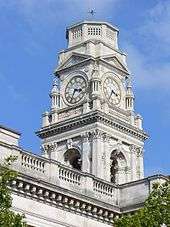Portsmouth Guildhall
Portsmouth Guildhall is a multi-use building in the centre of Portsmouth, UK, located on a pedestrian square close to the Portsmouth and Southsea railway station. Constructed in 1890 and originally used by the local council, the building was known as Portsmouth Town Hall until 1926. It was heavily damaged by bombing during the Second World War and largely rebuilt during the 1950s by the English architect Ernest Berry Webber. It now operates as a concert, wedding and conference venue. It is a Grade II listed building.[1]
| Portsmouth Guildhall | |
|---|---|
 | |
| Location | Portsmouth, Hampshire |
| Coordinates | 50.7979°N 1.0928°W |
| Built | 1890 |
| Architect | William Hill (original design); Ernest Berry Webber (rebuild) |
| Architectural style(s) | Neo-classical style |
Listed Building – Grade II | |
| Designated | 25 September 1972 |
| Reference no. | 1104316 |
 Location of Portsmouth Guildhall in Hampshire | |
History

The building, which was designed by William Hill in the Neo-classical style, was completed in 1890.[1] The building was initially known as the civic town hall but, on 21 April 1926, Portsmouth was raised to the status of a city and the town hall was simultaneously renamed the Guildhall.[2]
On 10 January 1941, during the Second World War, it was hit by enemy incendiary bombs. The resultant fire gutted the building, completely destroying the interior and roof. Just the outer walls and tower remained standing, and those were fire-damaged.[3] The Guildhall was entirely rebuilt at a cost of £1.5 million, over a four year period, starting in 1955, by the English architect Ernest Berry Webber. The interior was altered from the original and the external style is missing much of its original detail, especially the dome above the clock and the finials atop the balustrades around the roof.[3] It was reopened by Elizabeth II in 1959.[4]
Bells

There are five bells in its bell tower, collectively nicknamed The Pompey Chimes, as they inspired the football chant of the same name.[5] The largest of the five bells, Victoria is named after Queen Victoria and is inscribed with her name, and chimes on the hour.[6] The four quarter bells chime at 15, 30 and 45 minutes past the hour and play the Westminster Quarters, just before Victoria tolls on the hour.[7]
The Pompey Chimes fell silent in 2003 when the bell tower was found to be in need of restoration from the corrosive nature of sea salt in the Portsmouth air.[8] The work was carried out by Smith of Derby Group, the restoration project finishing in time for Queen Elizabeth's visit to Portsmouth in 2009 to mark the 65th anniversary of the D-Day landings.[9]
The four quarter bells were to have been officially named Nelson, Victory, John Pounds and Harry Redknapp in a 2008 public poll by Portsmouth City Council in 2008.[9] The official naming was stalled due to the high popularity of internet votes for Harry Redknapp's name from unregistered anonymous voters.[10] Redknapp, the former Portsmouth Football Club manager had suddenly departed the club for Tottenham Hotspur F.C. shortly before bell name voting commenced, which had left a wide range of emotions among many Portsmouth Football Club fans and city residents. Foul play, possibly from rival football supporters was suspected by Portsmouth City Council, who had organised the vote, and the four quarter bells have remained unnamed.[11]
Current use
The Guildhall now operates as a concert, wedding and conference venue. It has been managed by the Portsmouth Cultural Trust,a registered charity, since 2011.[12] The main hall has a standing capacity of up to 2,500 for concerts.[13]
References
- Historic England. "Guildhall, Portsmouth (1104316)". National Heritage List for England. Retrieved 27 August 2019.
- "Portsmouth Guildhall". www.portsmouth-guide.co.uk. Retrieved 27 August 2019.
- "Guildhall History". Portsmouth Guildhall. Retrieved 27 August 2019.
- "Guildhall rises from rubble", Hampshire Telegraph and Post, 22 March 1957, p. 3.
- "History of the chimes". www.portsmouth.co.uk. Retrieved 27 August 2019.
- "Pompey Chimes back where they belong!". www.portsmouth.co.uk. Retrieved 27 August 2019.
- Cambridge Quarters, Encyclopædia Britannica Ultimate Reference 2004
- "Smith of Derby website: Portsmouth Guildhall Bell Tower case study". Retrieved 27 August 2019.
- "Queen hears chimes on D-Day visit". 30 April 2009. Retrieved 27 August 2019 – via news.bbc.co.uk.
- "Bell name poll chimes a low note with council". www.portsmouth.co.uk. Retrieved 27 August 2019.
- "Chimes stay unnamed because Harry's in the frame". www.portsmouth.co.uk. Retrieved 27 August 2019.
- "Portsmouth Cultural Trust". Retrieved 25 March 2015.
- "Portsmouth Guildhall announces increased capacity". Retrieved 27 August 2019.
External links
| Wikimedia Commons has media related to Portsmouth Guildhall. |